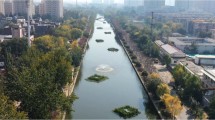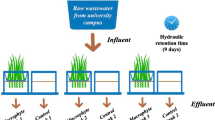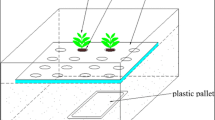Abstract
Though having an economic and ecological impact on Marriott Lake management in Egypt, water hyacinth (Eichhornia crassipes) is an aquatic floating macrophyte with a known phytoremediation potential. In order to assess its remediation potential, pilot floating treatment wetlands (FTWs) with E. crassipes were built in duplicates to evaluate the removal of nutrients and heavy metals from the polluted lake water. The experimental design included units with different water depths (15, 25, and 35 cm; D15, D25, and D35, respectively) and plant coverage (90, 70, 50, and 0%; P90, P70, P50, and P0, respectively). The pilot FTWs were monitored over a 7-day operation cycle to identify the optimum combination of design (plant coverage, water depth) and operation (hydraulic retention time; HRT) parameters needed for maximum BOD5, TN, NH4-N, and TP removal. NH4-N removal reached 97.4% in the D25P50 unit after 3 days, BOD5 75% in the D15P90 after 3 days, TN 82% in the D25P70 after 4 days, and TP 84.2% in the D35P70 after 4 days. The open-water evaporation rate was higher than the evapotranspiration rate in the planted units, probably due to the warm climate of the study area. Metals were also sufficiently removed through bioaccumulation in plant tissues in the order of Fe > Pb > Cu > Ni (62.5%, 88.9%, 81.7%, and 80.4% for D25P50, D25P70, D25P50, and D25P90, respectively), while most of the assimilated metal mass was translocated to the plant roots. The biochemical composition of the plant tissue was significantly different between the shoot and root parts. Overall, the FTW with 70% E. crassipes coverage, 25-cm water depth, and an HRT of 3–5 days was identified as the optimum design for effective remediation of the polluted Marriott Lake in Egypt.







Similar content being viewed by others
Data availability
The datasets used and/or analyzed in this study are available by the corresponding author on reasonable request (Saadga22@gmail.com).
Change history
05 February 2021
A Correction to this paper has been published: https://doi.org/10.1007/s11356-021-12789-x
References
Abdel-Shafy H (2002) Water issue in Egypt: resources , pollution and protection endeavors. Cent Eur J Med 8(1):1–21
Akinbile CO, Yusoff MS (2012) Assessing water hyacinth (Eichhornia Crassopes) and lettuce (Pistia Stratiotes) effectiveness in aquaculture wastewater treatment. Int J Phytoremediation 14:201–211
Ali YM, El-Din Khedr IS (2018) Estimation of water losses through evapotranspiration of aquatic weeds in the Nile River (Case study: Rosetta Branch). Water Sci 32:259–275
Ali S, Abbas Z, Rizwan M, Zaheer IE, Yavaş İ, Ünay A, Kalderis D (2020) Application of floating aquatic plants in phytoremediation of heavy metals polluted water: a review. Sustainability 12(5):1927
Allen ST, Edwards BL, Reba ML, Keim RF (2016) Sub-canopy evapotranspiration from floating vegetation and open water in a swamp forest. Wetlands 36:681–688
AOAC, 2000. Official methods of analysis, 17th Edition. Association of Official Analytical Chemists, Gaithersburg, MD, USA. Methods 925.10, 65.17, 974.24, 992.16. 2000.
APHA (2012) Standard methods for the examination of water and wastewater. American Public Health Association/American Waterworks Association/Water Environmental Federation, Washington, DC
ATSDR (2000) Toxicological profile for methylene chloride. Agency for Toxic Substances and Disease Registry. Atlanta, GA
Bonanno G, Vymazal J, Cirelli GL (2018) Translocation, accumulation and bioindication of trace elements in wetland plants. Sci Total Environ 631–632:252–261
Borker AR, Mane AV, Saratale GD, Pathade GR (2013) Phytoremediation potential of Eichhornia crassipes for the treatment of cadmium in relation with biochemical and water parameters. Emir J Food Agric 25:443–456
Chandra P, Kulshreshtha K (2004) Chromium accumulation and toxicity in aquatic vascular plants chromium accumulation and toxicity in aquatic vascular plants. Bot Rev 70:313–327
Colares GS, Dell’Osbel N, Wiesel PG, Oliveira GA, Lemos PHZ, da Silva FP, Lutterbeck CA, Kist LT, Machado EL (2020) Floating treatment wetlands: a review and bibliometric analysis. Sci Total Environ 714:136776
de Oliveira M, Atalla AA, Frihing BEF, Cavalheri PS, Migliolo L, Filho FJCM (2019) Ibuprofen and caffeine removal in vertical flow and free-floating macrophyte constructed wetlands with Heliconia rostrata and Eichornia crassipes. Chem Eng 373:458–467
Deshmukh AA, Bandela NN, Chavan JR, Nalawade PM (2013) Studies on potential use of water hyacinth, pistia and azolla for municipal waste water. Ind J Appl Res 3(11):2249–555X. https://doi.org/10.15373/2249555X/NOV2013/72
Ding X, Xue Y, Zhao Y, **ao W, Liu Y, Liu J (2018) Effects of different covering systems and carbon nitrogen ratios on nitrogen removal in surface flow constructed wetlands. J Clean Prod 172:541–551
El-Zokm GM, Ismail MM, Abd A, Mohsen E, El-shorbagi EK, Sheradah MA (2020) Mobility of carbohydrates, proteins, phenol and eutrophication assessment in a brackish Egyptian lake; predicted equations. Int J Environ An Ch 00:1–27
Fan J, Wang W, Zhang B, Guo Y, Ngo HH, Guo W, Zhang J, Wu H (2013) Nitrogen removal in intermittently aerated vertical flow constructed wetlands: Impact of influent COD/N ratios. Bioresour Technol 143:461
Ferraz-Almeida R, Lopes da Silva N, Wendling B (2020) How does N mineral fertilizer influence the crop residue N credit? Nitrogen 1:99–110. https://doi.org/10.3390/nitrogen1020009
Fonkou T, Agendia P, Kengne I, Akoa A, Nya J (2002) Potentials of water lettuce (Pistia stratiotes) in domestic sewage treatment with macrophytic lagoon systems in Cameroon. Proc Int Symp Environ Pollut Control Waste Manag 7:709–714
Gaballah MS, Ismail K, Beltagy A, Eldin AMZ (2017) Treatment of polluted lake water. LAP Lambert Academic Publishing, Bio-System Engineering Design For Wetland Water Treatment
Gaballah MS, Ismail K, Beltagy A, Zein Eldin AM, Ismail MM (2019) Wastewater treatment potential of water lettuce (Pistia stratiotes) with modified engineering design. J Water Chem Technol 41:197–205
Gaballah MS, Abdelwahab O, Barakat KM, Aboagye D (2020) A novel horizontal subsurface flow constructed wetland planted with Typha angustifolia for treatment of polluted water. Environ Sci Pollut Res 27:28449–28462. https://doi.org/10.1007/s11356-020-08669-5
Gao L, Zhou W, Huang J, He S, Yan Y, Zhu W, Wu S, Zhang X (2017) Nitrogen removal by the enhanced floating treatment wetlands from the secondary effluent. Bioresour Technol 234:243–252
Garcia CLM, White SA (2018) Aeration and plant coverage influence floating treatment wetland remediation efficacy. Ecol Eng 122:62–68
Gomes AC, Silva L, Albuquerque A, Simões R, Stefanakis AI (2018) Investigation of lab-scale horizontal subsurface flow constructed wetlands treating industrial cork boiling wastewater. Chemosphere 207:430–439
González CI, Maine MA, Cazenave J, Hadad HR, Benavides MP (2015) Ni accumulation and its effects on physiological and biochemical parameters of Eichhornia crassipes. Environ Exp Bot 117:20–27
Hadad HR, Maine MA, Mufarrege MM, Del Sastre MV, Di Luca GA (2011) Bioaccumulation kinetics and toxic effects of Cr, Ni and Zn on Eichhornia crassipes. J Hazard Mater 190:1016–1022
Henry-Silva GG, Camargo AFM (2008) Treatment of shrimp effluents by free-floating aquatic macrophytes. Rev Bras Zootec 37(2):181–188
Henry-Silva GG, Camargo AFM, Pezzato MM (2008) Growth of free-floating aquatic macrophytes in different concentrations of nutrients. Hydrobiologia 610:153–160
Huang J, Wang C, Qi L, Zhang X, Tang G, Li L, Guo J, Jia Y, Dou X, Lu M (2020) Phosphorus is more effective than nitrogen in restoring plant communities of heavy metals polluted soils. Environ Pollut 266:115259
Ioannidou V, Stefanakis AI (2020) The use of constructed wetlands to mitigate pollution from agricultural runoff. In: Naeem et al (eds) Contaminants in agriculture: sources, impacts and management. Springer Nature, Switzerland, pp 233–246
Ip Y, Chew SF, Randall DJ (2001) Ammonia toxicity, tolerance, and excretion. Fish Physiol 20:109–148
Kabenge I, Ouma G, Aboagye D, Banadda N (2018) Performance of a constructed wetland as an upstream intervention for stormwater runoff quality management. Environ Sci Pollut Res 25:36765–36774
Kadlec R, Wallace SD (2009) Treatment wetlands, 2nd edn. CRC Press, Boca Raton
Kaewtubtim P, Meeinkuirt W, Seepom S, Pichtel J (2017) Radionuclide (226Ra, 232Th, 40K) accumulation among plant species in mangrove ecosystems of Pattani Bay, Thailand. Mar Pollut Bull 115:391–400
Keizer-Vlek HE, Verdonschot PFM, Verdonschot RCM, Dekkers D (2014) The contribution of plant uptake to nutrient removal by floating treatment wetlands. Ecol Eng 73:684–690. https://doi.org/10.1016/j.ecoleng.2014.09.081
Krasimir I, Zaprjanova P, Angelova V, Bekjarov G, Dospatliev L (2010) ICP determination of phosphorous in soils and plants. In: 19th World Congress of Soil Science. Soil Solutions for a Changing World
Ladislas S, Gérente C, Chazarenc F, Brisson J, Andrès Y (2015) Floating treatment wetlands for heavy metal removal in highway stormwater ponds. Ecol Eng 80:85–91
Lallana V, Sabattini R, Lallana M (1987) Evapotranspiration from Eichhornia crassipes, Pistia stratiotes, Salvinia herzogii and Azolla caroliniana during summer in Argentina. J Aquat Plant Manag 25:48–50
Mahler BJ, van Metre PC, E.C. (2006) Trends in metals in urban and reference lake sediments across the United States, 1970 to 2001. Environ Toxicol Chem 25(7):1698–1709
Maine MA, Sune N, Hadad H, Sanchez G, Bonetto C (2007) Removal efficiency of a constructed wetland for wastewater treatment according to vegetation dominance. Chemosphere 68:1105–1113
Melignani E, de Cabo LI, Faggi AM (2015) Copper uptake by Eichhornia crassipes exposed at high level concentrations. Environ Sci Pollut Res 22:8307–8315
Mello D, Carvalho KQ, Passig FH, Freire FB, Borges AC, Lima MX, Marcelino GR (2019) Nutrient and organic matter removal from low strength sewage treated with constructed wetlands. Environ Technol 40(1):11–18
Mishra VK, Tripathi BD (2008) Concurrent removal and accumulation of heavy metals by the three aquatic macrophytes. Bioresour Technol 99:7091–7097
Naguib MI (1964) Effect of sevin on carbohydrate and nitrogen metabolism during germination of cotton seeds. Indian J Exp Biol 2:149–152
Naguib MI (1969) On the colorimetry of nitrogen components of plant tissues’. J Bull Fac Sci Cairo Univ 43:1–5
Newman MJ, Clausen JC, Neafsey JA (1999) Seasonal performance of a wetland constructed to process dairy milkhouse wastewater in Connecticut. Ecol Eng 14:181–198
NREA, 2013. New and Renewable Energy Authority. Egypt State of Environment Report 2012-2013, 380. https://doi.org/10.1017/CBO9781107415324.004.
Olguín EJ, Sánchez-Galván G, Melo FJ, Hernández VJ, González-Portela RE (2017) Long-term assessment at field scale of floating treatment wetlands for improvement of water quality and provision of ecosystem services in a eutrophic urban pond. Sci Total Environ 584-585:561–571
Oliveira-Junior ES, Tang Y, van den Berg SJP, Cardoso SJ, Lamers LM (July) Kosten S (2018) The impact of water hyacinth (Eichhornia crassipes) on greenhouse gas emission and nutrient mobilization depends on rooting and plant coverage. Aquat Bot 145:1–9. https://doi.org/10.1016/j.aquabot.2017.11.005
Osti JAS, do Carmo CF, Cerqueira MAS, Giamas MTD, Peixoto AC, Vaz-dos-Santos AM, Mercante CTJ (2020) Nitrogen and phosphorus removal from fish farming effluents using artificial floating islands colonized by Eichhornia crassipes. Aquac Rep 17:100324
Palihakkara CR, Dassanayake S, Jayawardena C, Senanayake IP (2018) Floating wetland treatment of acid mine drainage using Eichhornia crassipes (water hyacinth). J Health Pollut 8:14–19
Pavlineri N, Skoulikidis NT, Tsihrintzis VA (2017) Constructed floating wetlands: a review of research, design, operation and management aspects, and data meta-analysis. Chem Eng J 308:1120–1132
Rai PK (2019) Heavy metals/metalloids remediation from wastewater using free floating macrophytes of a natural wetland. Environ Technol Innov 15:100393
Rai R, Agrawal M, Agrawal SB (2016) Impact of heavy metals on physiological processes of plants: with special reference to photosynthetic system. In: Singh A, Prasad S, Singh R (eds) Plant responses to xenobiotics. Springer, Singapore, pp 127–140
Rehman K, Imran A, Amin I, Afzal M (2018) Inoculation with bacteria in floating treatment wetlands positively modulates the phytoremediation of oil field wastewater. J Hazard Mater 349:242–251
Rezania S, Ponraj M, Talaiekhozani A, Mohamad SE, Md Din MF, Taib SM, Sabbagh F, Sairan FM (2015) Perspectives of phytoremediation using water hyacinth for removal of heavy metals, organic and inorganic pollutants in wastewater. J Environ Manag 163:125–133
Saha P, Shinde O, Sarkar S (2017) Phytoremediation of industrial mines wastewater using water hyacinth. Int J Phytoremediation 19:87–96
Sanchez-Ramos D, Agulló N, Samsó R, García J (2017) Effect of key design parameters on bacteria community and effluent pollutant concentrations in constructed wetlands using mathematical models. Sci Total Environ 584–585:374–380. https://doi.org/10.1016/j.scitotenv.2017.01.014
Sasaqi D, Setyono P (2019) Estimation of water losses through evapotranspiration of water hyacinth (Eichhornia crassipes). Caraka tani: J Sustain Agric 34:86–100
Satyakala G, Jamil K (1992) Chromium-induced biochemical changes in Eichhornia crassipes (Mart) solms and Pistia stratiotes L. Bull Environ Contam Toxicol 921–928
Schück M, Greger M (2020) Screening the capacity of 34 wetland plant species to remove heavy metals from water. Int J Environ Res Public Health 17:4623. https://doi.org/10.3390/ijerph17134623
Schultze-Nobre L, Wiessner A, Bartsch C, Paschke H, Stefanakis AI, Aylward LA, Kuschk P (2017) Removal of dimethylphenols and ammonium in laboratory-scale horizontal subsurface flow constructed wetlands. Engineering in Life Sciences 17(12):1224–1233. https://doi.org/10.1002/elsc.201600213
Shahid MJ, Arslan M, Ali S, Siddique M, Afzal M (2018) Floating wetlands: a sustainable tool for wastewater treatment. Clean Soil Air Water 46. https://doi.org/10.1002/clen.201800120
Shanker AK, Cervantes C, Loza-tavera H, Avudainayagam S (2005) Chromium toxicity in plants. Environ Int 31:739–753
Shreadah MA, El-rayis OA, Shaaban NA, Hamdan AM (2020) Water quality assessment and phosphorus budget of a lake (Mariut, Egypt) after diversion of wastewaters effluents. Environ Sci Pollut Res 27(1):26786–26799. https://doi.org/10.1007/s11356-020-08878-y
Sricoth T, Meeinkuirt W, Pichtel J, Taeprayoon P, Saengwilai P (2018) Synergistic phytoremediation of wastewater by two aquatic plants (Typha angustifolia and Eichhornia crassipes) and potential as biomass fuel. Environ Sci Pollut Res 25:5344–5358. https://doi.org/10.1007/s11356-017-0813-5
Stefanakis AI (2016) Constructed wetlands: description and benefits of an eco-tech water treatment system. In: McKeown AE, Bugyi G (eds) Impact of water pollution on human health and environmental sustainability. IGI Global, Hershey, pp 281–303
Stefanakis AI (2019) The role of constructed wetlands as green infrastructure for sustainable urban water management. Sustainability 11(24):6981. https://doi.org/10.3390/su11246981
Stefanakis AI (2019) The role of constructed wetlands as green infrastructure for sustainable urban water management. Sustainability 11(24):6981. https://doi.org/10.3390/su11246981
Stefanakis AI (2020) Constructed wetlands for sustainable wastewater treatment in hot and arid climates: opportunities, challenges and case studies in the Middle East. Water 12(6):1665. https://doi.org/10.3390/w12061665
Stefanakis AI, Tsihrintzis VA (2012) Heavy metal fate in pilot-scale sludge drying reed beds under various design and operation conditions. J Hazard Mater 213-214:393–405
Stefanakis AI, Akratos CS, Tsihrintzis VA (2014) Modeling of Vertical Flow Constructed Wetlands. In: Vertical flow constructed wetlands: eco-engineering systems for wastewater and sludge treatment, first edn. Elsevier Publishing, Amsterdam
Stefanakis AI, Bardiau M, Silva D, Taylor H (2019) Presence of bacteria and bacteriophages in full-scale trickling filters and an aerated constructed wetland. Sci Total Environ 659:1135–1145
Stobart AK, Griffiths WT, Ameen-Bukthari I, Sherwood RP (1985) The effect of Cd2+ on the biosynthesis of chlorophyll in leaves of barley. Physiol Plant 63(3):293–298
Sukumaran D (2013) Phytoremediation of heavy metals from industrial effluent using constructed wetland technology. Appl Ecol Environ Sci 1:92–97
Tangahu BV, Sheikh Abdullah SR, Basri H, Idris M, Anuar N, Mukhlisin M (2011) A review on heavy metals (As, Pb, and Hg) uptake by plants through phytoremediation. Int J Chem Eng 2011 |Article ID 939161. https://doi.org/10.1155/2011/939161
Tanner CC, Headley TR (2011) Components of floating emergent macrophyte treatment wetlands influencing removal of stormwater pollutants. Ecol Eng 37:474–486
Van Der Weert R, Kamerling GE (1974) Evapotranspiration of water hyacinth (Eichhornia crassipes). J Hydrol 22(3-4):201–212
Vymazal J (2007) Removal of nutrients in various types of constructed wetlands. Sci Total Environ 380(1–3):48–65. https://doi.org/10.1016/j.scitotenv.2006.09.014
Vymazal J (2018) Does clogging affect long-term removal of organics and suspended solids in gravel-based horizontal subsurface flow constructed wetlands? Chem Eng J 331:663–674
Walker C, Tondera K, Lucke T (2017) Stormwater treatment evaluation of a constructed floating wetland after two years operation in an urban catchment. Sustainability 9(10):1687
Wang, C-Y, Sample, D.J., 2014. Assessment of the nutrient removal effectiveness of floating treatment wetlands applied to urban retention ponds. J Environ Manag 137, 23-35.
Weerakoon GMPR, **adasa KBSN, Herath GBB, Mowjood MIM, Zhang D, Tan SK, Jern NW (2016) Performance of tropical vertical subsurface flow constructed wetlands at different hydraulic loading rates. Clean Soil Air Water 44(8):938–948
Weragoda SK, **adasa KBSN, Zhang DQ, Gersberg RM, Tan SK, Tanaka N, Jern NW (2012) Tropical application of floating treatment wetlands. Wetlands 32:955–961
Yu K, Smith WK, Trugman AT, Condit R, Hubbell SP, Sardans J, ... Anderegg WRL (2019) Pervasive decreases in living vegetation carbon turnover time across forest climate zones. Proceedings of the National Academy of Sciences of the United States of America 116(49):24662–24667. https://doi.org/10.1073/pnas.1821387116
Zhang D, Tan SK, Jern NW, Lanka S, Lanka S (2016) Performance of tropical vertical subsurface flow constructed wetlands at different hydraulic loading rates. Clean Soil Air Water 44:1–11
Zhang L, Sun Z, **e J, Wu J, Cheng S (2018) Nutrient removal, biomass accumulation and nitrogen-transformation functional gene response to different nitrogen forms in enhanced floating treatment wetlands. Ecol Eng 112:21–25
Acknowledgments
We would like to express our deep gratitude to Prof. Ali Beltagy, Prof. Ebtessam El-Sayed, and my colleagues in Shore Processes Lab, Marine Environment Division, National Institute of Oceanography and Fisheries, Alexandria for their interest and valuable guidance, and colleagues in Shore Processes Lab., Alexandria, Egypt, for their immense support.
Funding
This study was financially supported by the Shore Processes Lab, Marine Environment Division, National Institute of Oceanography and Fisheries, Alexandria, Egypt.
Author information
Authors and Affiliations
Contributions
Mohamed S. Gaballah: Conceptualization, methodology, investigation, funding acquisition, and writing - original draft.
Khiary Ismail: Supervision, data acquisition, and methodology
Dominic Aboagye: Investigation and visualization
Mona M. Ismail: Data analysis and plant biochemical composition analysis
Mostafa Sobhi: Conceptualization and data acquisition
Alexandros I. Stefanakis: Conceptualization, data analysis, validation, and writing - review and editing
Corresponding author
Ethics declarations
Conflict of interest
The authors declare that they have no conflict of interest.
Ethical approval
Not applicable: our manuscript does not report on or involve the use of any animal or human data or tissue.
Consent to participate
Not applicable
Consent to publish
Not applicable
Additional information
Responsible Editor: Philippe Garrigues
Publisher’s note
Springer Nature remains neutral with regard to jurisdictional claims in published maps and institutional affiliations.
Rights and permissions
About this article
Cite this article
Gaballah, M.S., Ismail, K., Aboagye, D. et al. Effect of design and operational parameters on nutrients and heavy metal removal in pilot floating treatment wetlands with Eichhornia Crassipes treating polluted lake water. Environ Sci Pollut Res 28, 25664–25678 (2021). https://doi.org/10.1007/s11356-021-12442-7
Received:
Accepted:
Published:
Issue Date:
DOI: https://doi.org/10.1007/s11356-021-12442-7




